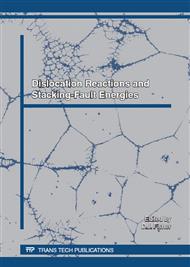[1]
Oelgardt, C., et al., Sintering, microstructure and mechanical properties of Al2O3-Y2O3-ZrO2 (AYZ) eutectic composition ceramic microcomposites. Journal of the European Ceramic Society, 30(3) (2010) 649-656.
DOI: 10.1016/j.jeurceramsoc.2009.09.011
Google Scholar
[2]
C. R. Ferrari, J.A.R., Microstructural features of alumina refractories with mullite-zirconia aggregates. Cerámica y Vidrio, (2003).
Google Scholar
[3]
Launey, M.E., et al., Designing highly toughened hybrid composites through nature-inspired hierarchical complexity. Acta Materialia, 57(10) (2009) 2919-2932.
DOI: 10.1016/j.actamat.2009.03.003
Google Scholar
[4]
Medvedovski, E., Alumina-mullite ceramics for structural applications. Ceramics International, 32(4) (2006) 369-375.
DOI: 10.1016/j.ceramint.2005.04.001
Google Scholar
[5]
Chen, T., F.A. Mohamed, and M.L. Mecartney, Threshold stress superplastic behavior and dislocation activity in a three-phase alumina-zirconia-mullite composite. Acta Materialia, 54(17) (2006) 4415-4426.
DOI: 10.1016/j.actamat.2006.05.002
Google Scholar
[6]
Awaad, M., M.F. Zawrah, and N.M. Khalil, In situ formation of zirconia-alumina-spinel-mullite ceramic composites. Ceramics International, 34(2) (2008) 429-434.
DOI: 10.1016/j.ceramint.2006.11.002
Google Scholar
[7]
W.H. Tuan, R.Z.C., T.C. Wang, C.H. Cheng, P.S. Kuo, Mechanical properties of Al2O3/ZrO2 composites. Journal of the European Ceramic Society, 22 (2002) 2827-2833.
DOI: 10.1016/s0955-2219(02)00043-2
Google Scholar
[8]
Chonghai Xua, X.A., Chuanzhen Huang, Fabrication and performance of an advanced ceramic tool materia. Wear, 249 (2001) 503-508.
Google Scholar
[9]
Khor, K.A. and Y. Li, Crystallization behaviors in the plasma-spheroidized alumina/zircon mixtures. Materials Letters, 48(2) (2001) 57-63.
DOI: 10.1016/s0167-577x(00)00280-9
Google Scholar
[10]
Mazzei, A.C. and J.A. Rodrigues, Alumina-mullite-zirconia composites obtained by reaction sintering: Part I. Microstructure and mechanical behaviour. Journal of Materials Science, 35(11) (2000) 2807-2814.
Google Scholar
[11]
Mazzei, A.C., J.A. Rodrigues, and V.C. Pandolfelli, Alumina-mullite-zirconia composites obtained by reaction sintering Part II. R-Curve behavior. Journal of Materials Science, 35(11) (2000) 2815-2824.
DOI: 10.1023/a:1004765326780
Google Scholar
[12]
Nevarez-Rascon, A., et al., Al2O3 (w)-Al2O3 (n)-ZrO2 (TZ-3Y) n multi-scale nanocomposite: An alternative for different dental applications? Acta Biomaterialia, 6(2) (2009) 563-570.
DOI: 10.1016/j.actbio.2009.06.029
Google Scholar
[13]
Orange, G., et al., High temperature mechanical properties of reaction-sintered mullite/zirconia and mullite/alumina/zirconia composites. Journal of Materials Science, 20(7) (1985) 2533-2540.
DOI: 10.1007/bf00556085
Google Scholar
[14]
Qiang, Q., et al., Reactive hot pressing and sintering characterization of ZrB2-SiC-ZrC composites. Materials Science and Engineering A, 491(1-2) (2008) 117-123.
DOI: 10.1016/j.msea.2008.01.053
Google Scholar
[15]
Yang, F.Z., J. Zhao, and X. Ai, Effect of initial particulate and sintering temperature on mechanical properties and microstructure of WC-ZrO2-VC ceramic composites. Journal of Materials Processing Technology, 209(9) (2009) 4531-4536.
DOI: 10.1016/j.jmatprotec.2008.10.027
Google Scholar
[16]
Singh, J.P.B., Narottam P.; Ustundag, Ersan, ed. Advances in Ceramic Matrix Composites VI. 2000, John Wiley & Sons Inc.
Google Scholar
[17]
Shike, Z., H. Xiaoxian, and G. Jingkun, The effect of mullite seeding on reaction-sintered mullite-zirconia multiphase ceramic. Journal of Materials Science Letters, 19(8) (2000) 707-710.
DOI: 10.1023/a:1006779131765
Google Scholar
[18]
Zhang, D., et al., Differential sintering of Al2O3/ZrO2–Ni composite, during pulse electric current sintering. (2005).
DOI: 10.1016/j.ceramint.2005.02.011
Google Scholar
[19]
Mukherjee, Y. -H.H. a.A.K., Nanostructured Bulk Ceramics (Part II. Superplasticity and High Strain Rate Superplasticity). Journal of the Korean Ceramic Society, (2009).
DOI: 10.4191/kcers.2009.46.4.345
Google Scholar
[20]
Byung-Koog Jang, a. b.M.E., b Teruo Kishi b and Hee-Kap Oh", Effect of second phase on mechanical properties and toughening of A12O3 based ceramic composites. Composite Engineering, 5(11) (1995) 1275-1286.
DOI: 10.1016/0961-9526(95)00069-y
Google Scholar
[21]
Zanelli, C., et al., Phase composition of alumina-mullite-zirconia refractory materials. Journal of the European Ceramic Society, 30(1) (2010) 29-35.
DOI: 10.1016/j.jeurceramsoc.2009.07.016
Google Scholar
[22]
Garrido, L.B., et al., Hardness and fracture toughness of mullite-zirconia composites obtained by slip casting. Materials Science and Engineering A, 419(1-2) (2006) 290-296.
DOI: 10.1016/j.msea.2006.01.035
Google Scholar
[23]
K. T. Kim, S.W.C., H. Park, Densification Behavior of Ceramic Powder Under Cold Compaction. ASME, 122 (2000).
Google Scholar
[24]
Chantikul, P., et al., A critical evaluation of indentation techniques for measuring fracture toughness: II, strength method. Journal of the American Ceramic Society, 64(9) (1981) 539-543.
DOI: 10.1111/j.1151-2916.1981.tb10321.x
Google Scholar
[25]
Evans, A.G. Fracture toughness: the role of indentation techniques. 1979: ASTM International.
Google Scholar
[26]
Anstis, G.R., et al., A critical evaluation of indentation techniques for measuring fracture toughness: I, direct crack measurements. Journal of the American Ceramic Society, 64(9) (1981) 533-538.
DOI: 10.1111/j.1151-2916.1981.tb10320.x
Google Scholar
[27]
Chen, T. and M.L. Mecartney, Superplastic compression, microstructural analysis and mechanical properties of a fine grain three-phase alumina-zirconia-mullite ceramic composite. Materials Science and Engineering A, 410-411 (2005) 134-139.
DOI: 10.1016/j.msea.2005.08.094
Google Scholar


